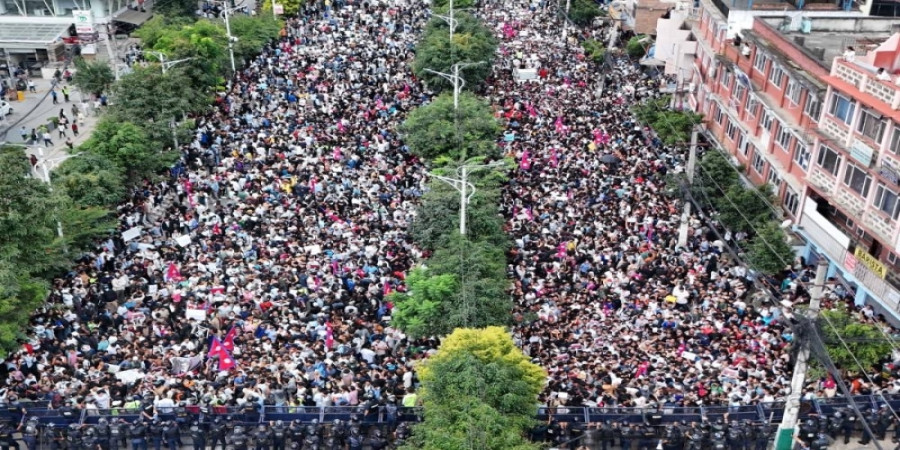
ছবি: -Collected Photo
The ongoing protests in Nepal’s capital, Kathmandu, have turned deadly, with the death toll rising to 14 as young demonstrators continue to challenge government restrictions on social media and demand accountability over corruption. The exact number of injured remains unclear, but hospitals across the city are struggling to accommodate the overwhelming influx of patients. Several have already been transferred to other medical facilities due to overcrowding.
According to reports from The Himalayan Times, fatalities have occurred across multiple hospitals in Kathmandu. Six victims died at the National Trauma Center, three at Civil Hospital, three at Everest Hospital, one at Kathmandu Medical College, and one at Tribhuvan University Teaching Hospital. Many of the injured are reported to be in serious condition, including journalists, security personnel, and civilian participants.
The protests, led largely by university students and younger citizens, were initially triggered by the government’s recent decision to block 26 social media platforms, including Facebook, WhatsApp, and X (formerly Twitter). Authorities cited concerns over the spread of “false information” and “anti-state propaganda” as justification for the bans. However, the move has been perceived by Nepal’s Gen Z as a direct attack on freedom of expression, sparking widespread outrage.
From early Monday morning, the streets of Kathmandu, particularly in the New Baneshwor area, saw groups of students and young citizens gathering in protest. Demonstrators carried placards reading slogans such as “End Corruption Now,” “Restore Freedom of Expression,” and “We Reject Social Media Ban.” What began as a largely peaceful march escalated into violent clashes by midday. According to eyewitness accounts, a group of protesters attempted to breach the main gate of the Federal Parliament. Security forces initially tried to block the entry with barricades but eventually resorted to tear gas, water cannons, and rubber bullets. Gunfire was also reported, intensifying the chaos.
Protesters have responded with makeshift shields, sticks, tree branches, and bottles in an effort to resist the crackdown. Many have raised anti-government slogans and voiced long-standing frustrations over systemic corruption, nepotism, and inefficient governance. Demonstrators accuse political leaders of failing to create job opportunities, maintain transparency, and deliver effective public services, fueling broader discontent among the population.
Authorities in Kathmandu have imposed a citywide curfew in an attempt to contain the unrest. The district administration announced that the curfew would remain in effect from 12:30 p.m. to 10:00 p.m. local time. Despite these restrictions, large numbers of protesters have defied the curfew, taking to the streets in defiance of the government order.
The scale and intensity of the protests highlight a significant generational shift in Nepalese politics. The younger generation, having grown up in a digitally connected era, views social media not merely as a tool for entertainment but as a critical platform for political dialogue, organization, and advocacy. The social media ban has therefore been interpreted as a direct assault on their ability to express dissent and participate in civic life.
Eyewitnesses report that the protests initially began outside the parliament building but quickly drew citizens from other parts of the city. Among the demonstrators were unemployed youth, small business owners, and even some government employees. The movement, initially focused on digital freedom, has evolved into a broader challenge to political accountability, economic stagnation, and systemic failures in governance.
Security forces have faced criticism for excessive use of force. Protesters allege that tear gas and rubber bullets were deployed against largely peaceful crowds, provoking panic and escalating tensions. Authorities, however, maintain that they are responding to attacks on police personnel and attempts to damage government property.
Political analysts suggest that the protests reflect deeper structural issues within Nepalese society. While the immediate trigger was the social media ban, the unrest also reflects accumulated frustration over economic difficulties, limited employment opportunities, and perceived governmental negligence. Many observers consider this wave of youth activism unprecedented in recent Nepalese history, noting that the government’s response could have far-reaching implications for social stability.
Despite the curfew and heightened security presence, protests remain concentrated in central Kathmandu, particularly around government offices and major thoroughfares. Both police and paramilitary forces have been deployed, yet demonstrators continue to resist, signaling sustained public anger.
As of now, the situation remains fluid. Hospitals are overwhelmed, law enforcement continues crowd control operations, and political leaders are under pressure from opposition parties demanding resignations and accountability. Citizens’ groups argue that the protests are about far more than social media access—they represent a broader struggle for democratic participation, government transparency, and a more equitable future.
The Nepalese government faces a critical challenge: balancing law enforcement with the citizens’ right to protest, particularly when much of the dissent is fueled by younger generations who have grown accustomed to digital connectivity and freedom of expression. The coming days will determine whether the unrest can be contained peacefully or whether Kathmandu will witness further escalation.
The protests in Nepal underscore a growing global pattern: as governments attempt to regulate digital spaces, young populations are increasingly willing to challenge restrictions, demanding both accountability and freedom. The events in Kathmandu serve as a stark reminder of the power of social media in shaping civic engagement and political movements in the 21st century.
repoter






